للحجر والجص تاريخ طويل في الفن والثقافات التي أصبحت فيما بعد تندرج تحت الحضارة الإسلامية، فقد تم استخدام الحجر في العصر البرونزي لصناعة أو نحت القرابين للحيوانات المقدسة والشياطين والآلهة وكانت الصخور رموزا تقديرية للمعتقد السائد انذاك.
ظل الحجر والجص الوسيلة المختارة كعنصر معماري اسلامي بارز ومميز، إذ تم صناعة النوافذ المثقوبة، التي تسمح بالتهوية مع توفير الخصوصية والظلال للداخل منها، إضافة لكونها مادة أساسية في العصور الإسلامية المبكرة والتي تم استخدامها في المباني الدينية والمدنية. فقد تم تطوير تقنيات الجص بشكل كبير وتم استخدامه بشكل واسع لتزيين الديكورات الداخلية للمباني وكذلك النوافذ.
ورث المعمارييون الإسلامييون تقليد نحت الحجر لتزيين الأجزاء الداخلية والخارجية للمباني من العالم القديم، ومن قصور وبلاطات الفترة المبكرة للعصور الإسلامية، وتحديدا من الخلفاء الأمويين الذين قاموا بتطوير الفنون وأضافوا فنون التوريق النباتي وفنون التجريد، وسرعان ما أصبحت تلك العناصر من أهم عناصر الزخرفة المعمارية في العالم الإسلامي. وسنجد تلك الفنون وتفاصيلها وتطورها على شواهد القبور، بتسلسل زمني، ومن خلال مجموعة متنوعة من فنون أنماط الخط.
وقد ساد استخدام الصخور في العصر المغولي، وتم انتاج العديد من الألواح الرخامية البيضاء المطعمة بالأحجار شبه الكريمة ومواد ملونة

قطع شطرنج من البّلور الصخري، من مجموعَتين مختلفَتين، ُنحت عليها بالحفر البارز مراوح وأنصاف مراوح نخيلية ( a، h ،
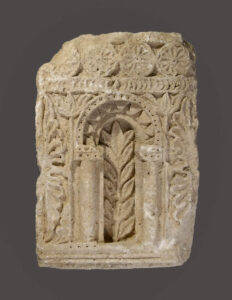
مشكاة من الحجر الجيري من قاعة الجمهور في مجمع القلعة في َعّمان-الأردن، ربما ُبنيت في حكم الخليفة الأموي هشام ابن
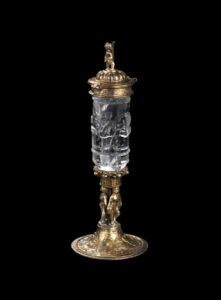
قارورة من البّلور الصخري، ُنحتت عليها كتابات كوفية بارزة، تدعو بطيب الأماني لصاحبها. ربما تكون هذه القارورة لحفظ الذخائر المقدسة،
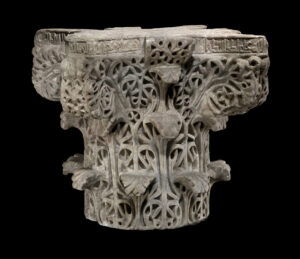
تاج عمود رخامي منحوت، مستوحى من الطراز الكورينثي، ُدونت عليه كتابات بالخط الكوفي، َتذكر اسم النحات، وهو الفتى ُشكر (أو
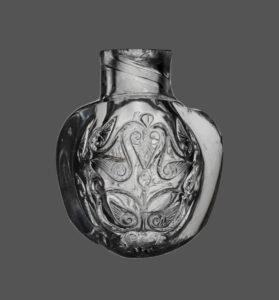
قارورة من البّلور الصخري، ُنحتت على وجهيها بالحفر البارز صورة محورة لشجرة الحياة، تحمل أنصاف مراوح نخيلية.
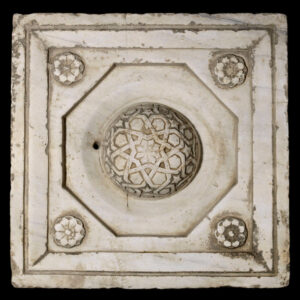
حوض فسقية من الرخام، تحتل أركاَنها زهيرات من الطراز الهندي؛ أما المركز، فتوجد فيه حلية بارزة نصف كروية، ُحفر عليها
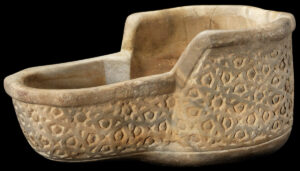
لوح معماري من الجص، كانت جزًءا من تكسية جدارية للجانب الأسفل من حائط، ُتظهر جانًبا من تصميم لانهائي من نجوم
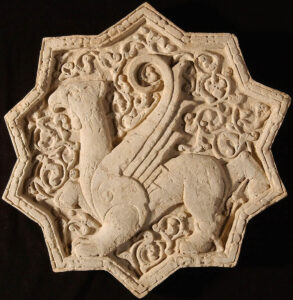
بلاطتان من الجص، تتخذان شكل نجمة عشرية، ُنحتت على إحداهما صورة كائن يجمع بين الأسد وطائر الغريفن الخرافي، وتصور الأخرى

عنصر معماري موَّرق من الحجر الرملي، ُنفذت زخارفه بالنحت البارز على شكل أوراق بتماثل ثنائي تنبثق من نصف زهيرة، وحليتين
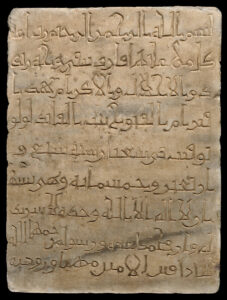
شاهد قبر من الرخام، عليه كتابات بالخط الكوفي تتضمن اسم ونسب السيدة أم الفتوح، بنت القائد لؤلؤ، وتاريخ وفاتها في
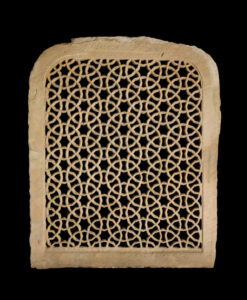
ساتر مخَّرم من الحجر الرملي (تعرف بالهند ب جالي)، ُصممت زخارفه على شكل نجوم سداسية تتكرر على شكل مثلثات متساوية
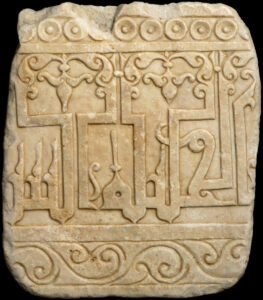
لوح معماري من الرخام، يحمل جزًءا من كتابات متقنة، تمثل أسلوًبا قديما من الخط الكوفي، نصها: “الجليلة الش[ريفة]”، ربما كانت

ضريح من حجر الشست، للأمير شمس الدين محمد، ابن الأمير نظام الدين والي بايك، منقوش بكتابات بالفارسية والعربية بخط الثلث،
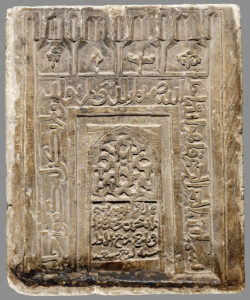
شاهد قبر من الحجر الكلسي، على شكل محراب ذي مقرنصات، ُنقشت عليه كتابات بخط النسخ (ُنقشت على الإطار الداخلي المستطيل
قد يعجبك أيضًا
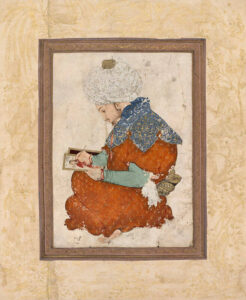
تحتوي مجموعة الصباح على عدد وفير من مخطوطات القرآن الكريم، والتي تضم صفحات مزدوجة لواحدة من أقدم المخطوطات القرآنية المعروفة، والتي تم نسخها في القرن الثاني بخط رأسي مميز يعرف باسم “الحجازي”، إضافة إلى مخطوطة كبيرة الحجم، مزينة بشكل رائع،

للحجر والجص تاريخ طويل في الفن والثقافات التي أصبحت فيما بعد تندرج تحت الحضارة الإسلامية، فقد تم استخدام الحجر في العصر البرونزي لصناعة أو نحت القرابين للحيوانات المقدسة والشياطين والآلهة وكانت الصخور رموزا تقديرية للمعتقد السائد انذاك.
ظل الحجر والجص
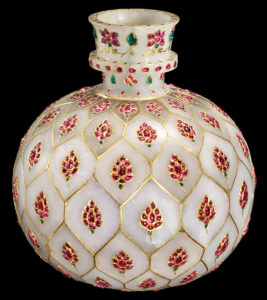
تحتوي مجموعة الصباح الآثارية على مجموعة لامثيل لها من المجوهرات والأحجار الكريمة، ولا تجسد مدى جمال القطع فقط، بل المهارات الجمالية والتقنية لأجيال من الحرفيين والفنانين.
إضافة لكونها المجموعة الأكبر والأكثر احتواءً على المجوهرات الإسلامية في العصور الوسطى على مستوى